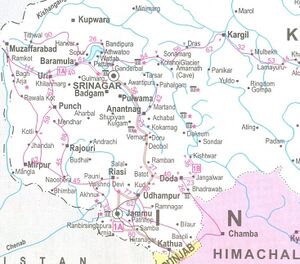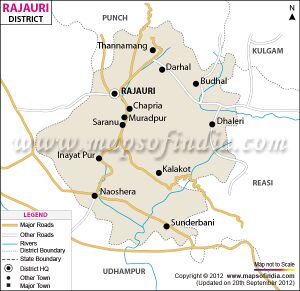Rajauri
| Author:Laxman Burdak, IFS (Retd.) |

Rajauri or Rajouri (राजौरी) is a town and district in Jammu and Kashmir.
Contents
Variants of name
- Rajauri राजौरी दे. Rajapura राजपुर (1) (AS, p.784)
- Ko-lo-she-pu-lo (by Xuanzang)
- Raj Avar
- Raj Vara
- Raj Vari
- Raja Puri
- Raja Vari
- Rajaori (by Alexander Cunningham)
- Rajapura(by Alexander Cunningham)
- Rajapuri
- Raj-Avar
- Rajour
- Rajouri
- Rajpuri
Location
Rajauri is about 130 kms from Jammu city on the Poonch Highway. Rajauri is known as the Vale of Lakes as there are many lakes around the city. Rajauri is located at 33.38°N 74.3°E. It has an average elevation of 915 metres.
The people
The people are mostly Gujjars and Paharis. Muslims make up 55% of the population, Hindus 42% and Sikhs 2.4%.
Administrative divisions
There are nine blocks: Rajouri, Darhal, Sunderbani, Doongi, Nowshera, Kalakote, Manjakote, Thanamandi and Budhal Tehsil.
History
V. S. Agrawala[1] writes that Ashtadhyayi of Panini mentions janapada Uśīnara (उशीनर) (IV.2.118) - Panini mentions Ushinara as part of Vahika. Panini mentions three divisions of Vahika Country, viz Kekaya, Uśīnara and Madra. Fourth division to be added to Vahika country is Śavasa. Of these Kekaya and Śavasa may be located between Jhelum and Chenab, the first in the south and second in north respectively; Madra and Ushinara between the Chenab and Ravi River in the north and south respectively.
The Divyadana refers to the Shvasas in Uttarapatha with headquarters at Takshasila to which Ashoka was deputed by his father Bindusara as Viceroy to quell their rebellion. The name of Savasa or Shvasa seems to be preserved in in the modern name Chhiba comprising of Punchh, Rajauri and Bhimbhara. In literature Ushinaras are often associated with the Śibis (greek - Siboi) whose chief town Śibipura has been identified with Shorkot in Jhang district.
Ancient History: According to some historians, a second branch of Aryan emigrants crossed the Himalayas in the north and west and settled in Rajouri and Poonch area. Rajouri, Bhimber Gali and Naushera were integrated within the territory of Abhisar, which was one of the hill states of the Punjab Kingdom.
Early records of incomplete nature show that in the 4th century B.C.E., there existed in the north west of India a federal type of political set up in which Abhisar with its capital Rajouri was also incorporated. At the time of Alexander's invasion, Rajouri was at the summit of its splendour. In the Mauryan period, the town of Rajouri was a great trade centre.
Medieval History:
During the Mughal rule, the rulers of Rajouri converted to Islam though they retained the title of Raja. Albaruni visited Rajouri with Sultan Masud (Son of Sultan Mahmud) in 1036 C.E. In his book "India" he wrote name of Rajouri as Raja Vari.
Srivar, the writer of Rajatarangini written during the administration of Sultan Zain-Ul-Abdin, also named this area as Raja Vari. It is believed that Raja Vari is a variant of Rajapuri.
Mirza Zafarulla Khan, the writer of 'Tarikh Rajgan-E-Rajour' illustrated in his book that this place was in the beginning known as Raj-Avar and then altered from Rajour to Rajouri. But the old people in the villages still label the place as Rajour.
With the course of time the name changed from Raja's Raj Avar to Raja Puri, Rajpuri to Raj Vari, Raj Vari to Raj Vara, Raj Vara to Raj Avar, Raj Avar to Rajour and then Rajour to Rajouri.
As per Rajatarangini of Kalhan, Rajouri emerged as principality in about 1003 C.E. The first ruler of this kingdom was Raja Prithvi Paul. From 1033 to 1194 C.E. Raja Prithvi Paul defended Pir Panchal Pass at the time of incursion of Sultan Mehmud in 1021 C.E. Raja Sangram Paul safeguarded his Principality Rajouri when Raja Harasha of Kashmir attacked his country in 1089 A.D. Sangram Paul fought so courageously that Raja Harash was obliged to return from Prithvi Paul fort without capturing Rajouri. Jaral Muslim Rajas rebuilt Rajouri city at the time of their rule. A number of forts, sarais, mosques and baradaris were constructed.
Jat History
Babu Lal Puniya (Sepoy) (15.03.1978 - 21.08.2002) became martyr on 21.08.2002 in Rajauri sector of Jammu and Kashmir fighting with militants. He was from Bai village in Nawalgarh tahsil of Jhunjhunu district of Rajasthan.
Unit: 45 Rashtriya Rifles/4 Jat Regiment.
Ravinder Chhikara (Lt.) , of 6th Grenadiers, made supreme sacrifice for the country on 19 July 2000 in Rajori (Jammu and Kashmir) while fighting with terrorists. He was awarded Kirti Chakra (posthumous) for this act of bravery.
Vineet Gulia (Major) lost his life on 8 November 2020 while fighting with insurgents in Rajouri sector of J&K. 29-year old Maj. Vineet Gulia was deployed in Rajouri sector of Jammu division and belonged to Rashtriya Rifles. He was from Daryapur village in Jhajjar district of Haryana.
In Rajatarangini
Rajatarangini[2] writes that On the death of Phalguna, the king of Rajapuri became very insolent, which led to an attack on him by the ministers of Kashmira. In the battle which ensued with Prithvipala, commander of the Rajapuri forces, many were destroyed on either side. Two of the ministers of Kashmira Shipātaka and Hansaraja perished. But Tungga with his brothers suddenly entered the city by another way, and set it on fire. The Rajapuri army well as Prithvipala and their king were defeated, and the king
[p.167]: now humbled consented to pay tribute to Tungga ; be that Tungga recovered the money which was spent in the war. Returning to the capital of Kashmira, the powerful Tungga accepted the lordship of Kampana and destroyed the villages of the Damaras.
Rajouri saw some of the toughest fighting during Pakistani intervention in Kashmir during Operation Gibraltar. The town was initially captured from the Indian Army by undercover Pakistani commandos with the aid of local Mujahideen but the wider operation failed and, with all-out war with India looming, Pakistan withdrew it's troops. Major Malik Munawar Khan Awan, a Pakistani commando officer who led the attack on Rajouri on the night of 6 August 1965, was later entitled with the name "King of Rajouri" by the Government of Pakistan. (VI,p.166-167)
Rajatarangini[3] tells that Sahajapala king of Rajapuri died and was succeeded by his son Sanggramapala. The king's uncle (father' a brother) the powerful Madanapala attempted to snatch the kingdom from the hands of the boy. Afraid of Madanapala the young king's sister and Jassaraja the Thakkura came for help to the king of Kashmira. The king was pleased with them and sent them back, accompanied by Jayananda, Vijja and others. Jayananda drove the enemy from the country, and became as powerful as the ministers of Sanggramapala. The ministers therefore wished for his departure and tried to frighten him in various ways, but in vain. Jayanauda suspected that, it was Vijja who advised the people of Rajapuri to act thus towards him and became angry with him. The people gave him riches and prayed for his departure. On the pretence of keeping the kingdom safe from enemies,.
[p.208]: he left his army there, and returned to Kashmira. The king of Kashmira was very much pleased with him as he had managed to keep Rajapuri under control. Vijja and others conducted themselves in a kingly style. (VII, p.207-208)
Rajatarangini[4] tells...In order to attack Sussala, the mad king sent Vimba with an army to Lohara by the Rajapuri road. After Vismaya of Sallara had become his friend, the king, accompanied with Somapala, brought an army of Turushka to aid Vimba ; and to every individual Turushka he showed a cord and said that he would bind and drag Sussala with it. (VIII,p.76)
Visit by Xuanzang in 633 AD
Alexander Cunningham[5] writes about 6. Rajapura or Rajaori:
[p.129]: From Punach, Hwen Thsang proceeded to the south-east for 400 li, or 67 miles, to Ko-lo-she-pu-lo, or Rajapura1 which I long ago identified with the petty chief ship of Rajaori, to the south of Kashmir. The circuit of the district is described as 4000 li, or 667 miles, which is about double the true amount, unless, as is not improbable, the whole of the hill-states as far as the Ravi be included within its boundaries.
From the native chronicle of Kashmir we learn that the petty chiefships of the hills to the south and south-east of the valley were generally subject to Kashmir ; and there is no reason to suppose that they were independent at the time of Hwen Thsang's visit. The district of Rajaori proper is nearly a square of about 40 miles each side, bounded on the north by the Pir Panchal, on the west by Punach, on the south by Bhimbar, and on the east by Rihasi and Aknur.2 By extending its boundary on the east to the Chenab,
1 Julien's ' Hiouen Thsang,' ii. 188.
2 See Maps Nos. V. and VI.
[p.130]: and on the south to the plains, it would include all these petty places ; even then its frontier would not be more than 240 miles, or by road about 320 miles. But if the frontier of these hill-states subject to Kashmir be extended to the Ravi on the east, the circuit would be about 420 miles measured on the map, or not less than 560 miles by road.
Rajapuri is frequently mentioned during the medieval period of Kashmirian history, but chiefly in the eleventh and twelfth centuries, when it was an independent state under its own rajas. In the fifteenth century the Hindu family was dispossessed in favour of a son of the Muhammadan king of Kashmir ; and his descendant was so reduced by Gulab Singh that in 1846 he was glad to accept an estate in the British district of Kangra in exchange for his petty chiefship of Rajaori.
References
- ↑ V. S. Agrawala: India as Known to Panini, 1953, p.53
- ↑ Rajatarangini of Kalhana:Kings of Kashmira/Book VI,pp.166-167
- ↑ Rajatarangini of Kalhana:Kings of Kashmira/Book VII, p.207-208.
- ↑ Kings of Kashmira Vol 2 (Rajatarangini of Kalhana)/Book VIII,p.76
- ↑ The Ancient Geography of India/Singhapura, pp. 129-130


